2д. 2.1 x² + y? Examine the behavior of f(x, y) as (x, y) approaches (0, 0). (a) Changing to polar coordinates, we find 2x2.1 lim (x,y)→(0,0) \ x2 + y? lim r→0+, 0=anything (1)=0 Use "theta" for 0. Use "infinity" for "o" and "-infinity" for "-oo". Use "DNE" for "Does not exist". (b) Since f(0, 0) is undefined, f has a discontinuity at (x, y) = such that g(x, y) = f(x,y) for all (æ, y) + (0,0) and g is continuous everywhere? If so, what would the value of g(0, 0) be? If there is no continuous function g, enter DNE. = (0,0). Is it possible to define a function g : R² → R
2д. 2.1 x² + y? Examine the behavior of f(x, y) as (x, y) approaches (0, 0). (a) Changing to polar coordinates, we find 2x2.1 lim (x,y)→(0,0) \ x2 + y? lim r→0+, 0=anything (1)=0 Use "theta" for 0. Use "infinity" for "o" and "-infinity" for "-oo". Use "DNE" for "Does not exist". (b) Since f(0, 0) is undefined, f has a discontinuity at (x, y) = such that g(x, y) = f(x,y) for all (æ, y) + (0,0) and g is continuous everywhere? If so, what would the value of g(0, 0) be? If there is no continuous function g, enter DNE. = (0,0). Is it possible to define a function g : R² → R
Calculus: Early Transcendentals
8th Edition
ISBN:9781285741550
Author:James Stewart
Publisher:James Stewart
Chapter1: Functions And Models
Section: Chapter Questions
Problem 1RCC: (a) What is a function? What are its domain and range? (b) What is the graph of a function? (c) How...
Related questions
Question

Transcribed Image Text:11.1 11.2: Problem 4
2x2.1
Examine the behavior of f(x, y)
as (x, y)
x² + y?
approaches (0, 0).
(a) Changing to polar coordinates, we find
(1) =
2x2.1
lim
(x,y)→(0,0)
)
x² + y?
lim
r→0+, 0=anything
0
Use "theta" for 0. Use "infinity" for "o" and "-infinity" for "-∞". Use
"DNE" for "Does not exist".
(b) Since f(0,0) is undefined, f has a discontinuity at
(x, y) = (0,0). Is it possible to define a function g : R² → R
such that g(x, y) = f(x,y) for all (x, y) # (0,0) and g is
continuous everywhere? If so, what would the value of g(0, 0)
be? If there is no continuous function
g,
enter DNE.
g(0,0) =
Expert Solution
This question has been solved!
Explore an expertly crafted, step-by-step solution for a thorough understanding of key concepts.
This is a popular solution!
Trending now
This is a popular solution!
Step by step
Solved in 2 steps with 1 images

Recommended textbooks for you

Calculus: Early Transcendentals
Calculus
ISBN:
9781285741550
Author:
James Stewart
Publisher:
Cengage Learning

Thomas' Calculus (14th Edition)
Calculus
ISBN:
9780134438986
Author:
Joel R. Hass, Christopher E. Heil, Maurice D. Weir
Publisher:
PEARSON

Calculus: Early Transcendentals (3rd Edition)
Calculus
ISBN:
9780134763644
Author:
William L. Briggs, Lyle Cochran, Bernard Gillett, Eric Schulz
Publisher:
PEARSON

Calculus: Early Transcendentals
Calculus
ISBN:
9781285741550
Author:
James Stewart
Publisher:
Cengage Learning

Thomas' Calculus (14th Edition)
Calculus
ISBN:
9780134438986
Author:
Joel R. Hass, Christopher E. Heil, Maurice D. Weir
Publisher:
PEARSON

Calculus: Early Transcendentals (3rd Edition)
Calculus
ISBN:
9780134763644
Author:
William L. Briggs, Lyle Cochran, Bernard Gillett, Eric Schulz
Publisher:
PEARSON

Calculus: Early Transcendentals
Calculus
ISBN:
9781319050740
Author:
Jon Rogawski, Colin Adams, Robert Franzosa
Publisher:
W. H. Freeman


Calculus: Early Transcendental Functions
Calculus
ISBN:
9781337552516
Author:
Ron Larson, Bruce H. Edwards
Publisher:
Cengage Learning